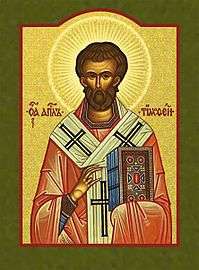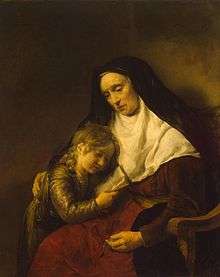Saint Timothy
Timothy (Greek: Τιμόθεος; Timótheos, meaning "honouring God" or "honoured by God"[4]) was an early Christian evangelist and the first Christian bishop of Ephesus,[5] who tradition relates died around the year AD 97.
Timothy | |
|---|---|
 Icon of Saint Timothy | |
| Bishop, Martyr | |
| Born | c. AD 17 Lystra |
| Died | c. AD 97 (aged 79/80) Macedonia |
| Venerated in | Roman Catholic Church Eastern Orthodox Church Oriental Orthodoxy Anglican Communion Lutheran Church |
| Feast | January 22 (Eastern Christianity) January 26 (Roman Catholic Church, Lutheranism) January 24 (some local calendars and pre-1970 General Roman Calendar) 23 Tobi (Coptic Christianity)[1] 27 Tobi (Relocation of Relics - Coptic Christianity)[2] |
| Attributes | pastoral staff[3] |
| Patronage | invoked against stomach and intestinal disorders |
Timothy was from the Lycaonian city of Lystra in Asia Minor, born of a Jewish mother who had become a Christian believer, and a Greek father. The Apostle Paul met him during his second missionary journey and he became Paul’s companion and co-worker along with Silas.[6] The New Testament indicates that Timothy traveled with Paul the Apostle, who was also his mentor. Paul entrusted him with important assignments. He is addressed as the recipient of the First and Second Epistles to Timothy.
Life
Timothy was a native of Lystra in Lycaonia (Anatolia).[7] When Paul and Barnabas first visited Lystra, Paul healed a person crippled from birth, leading many of the inhabitants to accept his teaching. When he returned a few years later with Silas, Timothy was already a respected member of the Christian congregation, as were his grandmother Lois and his mother Eunice, both Jews. In 2 Timothy 1:5, his mother and grandmother are noted as eminent for their piety and faith. Timothy is said to have been acquainted with the Scriptures since childhood. In 1 Corinthians 16:10 there is a suggestion that he was by nature reserved and timid: "When Timothy comes, see that you put him at ease among you, for he is doing the work of the Lord".[8]
Timothy's father was a Greek Gentile. Thus Timothy had not been circumcised and Paul now ensured that this was done, according to Acts 16:1–3, to ensure Timothy's acceptability to the Jews whom they would be evangelizing. According to McGarvey:[9] "Yet we see him in the case before us, circumcising Timothy with his own hand, and this 'on account of certain Jews who were in those quarters'". This did not compromise the decision made at the Council of Jerusalem, that gentile believers were not required to be circumcised.


Timothy became St Paul’s disciple, and later his constant companion and co-worker in preaching.[10] In the year 52, Paul and Silas took Timothy along with them on their journey to Macedonia. Augustine extols his zeal and disinterestedness in immediately forsaking his country, his house, and his parents, to follow the apostle, to share in his poverty and sufferings.[11] Timothy may have been subject to ill health or "frequent ailments", and Paul encouraged him to "use a little wine for your stomach's sake".[12]
When Paul went on to Athens, Silas and Timothy stayed for some time at Beroea and Thessalonica before joining Paul at Corinth.[11] Timothy next appears in Acts during Paul's stay in Ephesus (54–57), and in late 56 or early 57 Paul sent him forth to Macedonia with the aim that he would eventually arrive at Corinth. Timothy arrived at Corinth just after Paul's letter, 1 Corinthians reached that city.
Timothy was with Paul in Corinth during the winter of 57–58 when Paul dispatched his Letter to the Romans (Romans 16:21). According to Acts 20:3–6, Timothy was with Paul in Macedonia just before Passover in 58; he left the city before Paul, going ahead of him to await Paul in Troas (Acts 20:4–5). "That is the last mention of Timothy in Acts", Raymond Brown notes.[13] In the year 64, Paul left Timothy at Ephesus, to govern that church.[11]
His relationship with Paul was close and Paul entrusted him with missions of great importance. Timothy's name appears as the co-author on 2 Corinthians, Philippians, Colossians, 1 Thessalonians, 2 Thessalonians, and Philemon. Paul wrote to the Philippians about Timothy, "I have no one like him" (Philippians 2:19–23). When Paul was in prison and awaiting martyrdom, he summoned his faithful friend Timothy for a last farewell.[10]
That Timothy was jailed at least once during the period of the writing of the New Testament is implied by the writer of Hebrews mentioning Timothy's release at the end of the epistle.
Although not stated in the bible, other sources have records of the apostle's death. The apocryphal Acts of Timothy states that in the year 97 AD, the 80-year-old bishop tried to halt a procession in honor of the goddess Diana by preaching the gospel. The angry pagans beat him, dragged him through the streets, and stoned him to death.[10]
Veneration
Timothy is venerated as an apostle, saint, and martyr by the Eastern Orthodox Church, with his feast day on 22 January. The General Roman Calendar venerates Timothy together with Titus by a memorial on 26 January, the day after the Feast of the Conversion of Saint Paul. From the 13th century until 1969 the feast of Timothy (alone) was on 24 January, the day before that of the Conversion of Saint Paul.[14] Along with Titus and Silas, Timothy is commemorated by the Evangelical Lutheran Church in America and the Episcopal Church on 26 January. Timothy's feast is kept by the Lutheran Church–Missouri Synod on 24 January.
In the 4th century, the relics of Timothy were transferred from Ephesus to Constantinople and placed in the Church of the Holy Apostles near the tombs of Andrew and Luke.[10] Later on in the 13th century, the relics seem to have been taken to Italy by a count returning from the crusades, and buried around 1239 in the Termoli Cathedral.[15] The remains were re-discovered in 1945, during restoration works.
Saint Timothy is also the protagonist of Gore Vidal's novel Live from Golgotha (1992).
Patronage
Timothy is the patron invoked against stomach and intestinal disorders.[16]
See also
- Eunice (mother)
- Lois (grandmother)
- Acts of Timothy
- First Epistle to Timothy
- Second Epistle to Timothy
- Clement of Rome
References
- "The Martyrdom of St. Timothy, the Apostle.", Coptic Orthodox Church Network
- "The Relocation of the Relics of St. Timothy, the Apostle.", COCN
- Agasso, Domenico. "Saint Timothy, Bishop", Santi e Beati, February 1, 2001
- "Timothy". Finde. Zelo. Retrieved 2017-06-18.
- Eusebius (1965), "3.4", Historia Ecclesiastica [The History of the Church], Williamson, G.A. transl., Harmonsworth: Penguin, p. 109.
- Acts 16:1–4
- "St. Timothy biography". St. Timothy ELCA. Retrieved 2017-06-18.
- "Who Was Saint Timothy". Fort Worth, TX: St.Timothy's Episcopal Church. Archived from the original on 2014-11-14. Retrieved 2014-01-17.
- "Commentary on Acts of the Apostles". Christian Classics Ethereal Library. Retrieved 2017-06-18.
- "Apostle Timothy of the Seventy". Lives of the saints. OCA. 2013-01-22. Retrieved 2017-06-18.
- Butler, Alban. Saint Timothy, Bishop and Martyr. The Lives of the Saints. I: January. Bartleby. Retrieved 2017-06-18.
- "Saints Timothy and Titus", Franciscan Media
- Brown (1997), An Introduction to the New Testament, New York: Doubleday, p. 655.
- Calendarium Romanum (Vatican City, 1969), p. 86.
- Sanidopoulos, John (September 2011), Skull of apostle Timothy to travel to….
- "St. Timothy – Why is He the Patron of Stomach Issues?". Bible saints. January 2017. Retrieved 2018-07-05.
External links
| Wikimedia Commons has media related to Saint Timothy. |